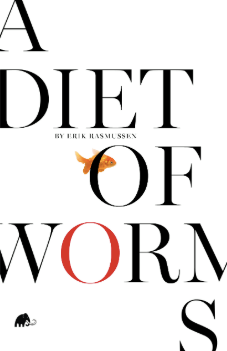
REVIEW BY PRATIMA BALABHADRAPATHRUNI
__
Erik Rasmussen’s first novel, published by Mastodon, has the most intriguing title I have seen for some time. A Diet of Worms, though, is both historically and theologically relevant. In 1521, Charles the Fifth convened a council in Worms, commonly referred to as the Diet of Worms, where Martin Luther was asked to defend his beliefs.
I open the first page with two question on my mind: Why the goldfish? Why the title?
“There are a thousand ways to tell how things happened. But there’s no way to know why. You have to pick a reason out of thin air. Then you have to explain it with the same words you use to talk about your shoe. Why should be like a yawn, something everyone understands immediately.”
The book is intriguing; after one read, I still can recollect my favorite instances: the brilliant conversation the teacher Mr. Brush has with Larry as he consoles Larry, using quantum physics as a starting point. Rasmussen’s dialogue is both brilliant and ludicrous. The author is able to conjure for us the old memories of growing up through his everyday characters, elucidating and illustrating with instances that can be easily visualized. There are no greater-than-life characters. There are no spectacular abilities attached to any of them. There is, however, the institutionalized system of everyday life as it is, and how it influences Larry, who could be the kid living next door. Admittedly, this is his story, with a bullet in his pocket and an ailing father being the son of a gun, the white noise in the background, the man who eats the goldfish and is gone without a good-bye. This is also the story of Larry’s increasing awareness of life, loyalties, friendships and bonds. Like all teenagers, Larry, too, outgrows his adolescent skins.
“When your friend likes a girl, he becomes this whole other person …”
Larry sounds real. So do Joey, Ashley, Alexis, Demaris, Mr. Brush, and anyone else in the book; they all ring true. None of them read as farcical or flat. They all have their own kind of variable, complex lives. Larry, however, seems to be helplessly caught up in the buccaneering world around his budding adolescence. There is no catcher in the rye out there to help him. Friends, girlfriends, father, fate, life, everything seems to spin out of control, move on, and, for a brief moment that lingers, leave Larry behind.
When I was young, I always was surprised that the immobile train on parallel tracks seemed to move along, until we sped past, and there was just the wide expanse of world around, through the tiny window. For me, Larry seems to be the moving train, speeding away until he is a ferocious blur.
It is however, his journey’s closure that wraps it up for me. Here is where the book actualizes its theological argument. Ironically, it is also when I stumble upon the author’s reasoning for choosing the particular title for his book. Except I have to add that the “Diet of Worms” issued an “Edict of Worms”–and I am left wondering whether Rasmussen will come up with a sequel for this stirring debut. Larry, after all, is only seventeen years old as the novel concludes. Ten days after reading the book, I can still see the story happening in my head: a read that was alternately fast- and slow-paced; an experience in which very often, the words flew off the page.
“The path was narrow as your shoelace, and up ahead, ten feet, it disappeared beneath the heel of an enormous night.”
The reader can either accept the book as a simple story of growing up or come to terms with the fact that there are more than one way to read a book. Like Larry points out, when it comes to God, people can argue and go on for hours. I can say the same about books.
Goldfish, do you agree?
__
Pratima Balabhadrapathruni is a homemaker, writer, and poet. A winner of the in the Poetry Sans Frontieres contest twice in a row, she also has been chosen for the 2014 IWP workshop in non-fiction conducted by the University of Iowa. Her work has appeared in OTATA, and Haiku Presence, Haibun Today, and other publications.
![[PANK]](https://pankmagazine.com/wp-content/themes/pank/assets/images/pank-logo-large.png)
